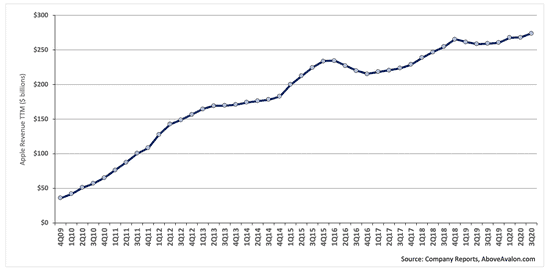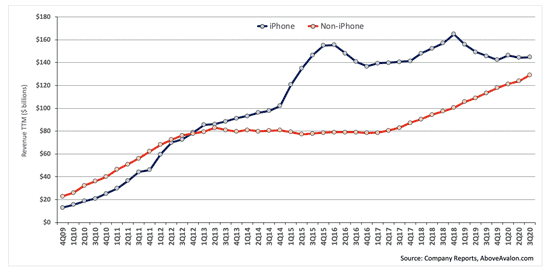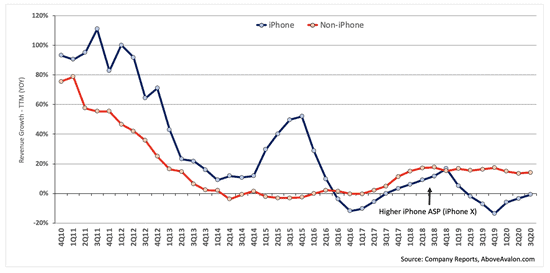In recent years, iPhone sales are not as good as before. So many people began thinking that Apple is in a big trouble now. However, the truth is Apple is now completing the transformation from selling products to selling services. For the prove, just look at the number of the service business – it is steadily growing. On the other hand, Apple’s non-iPhone hardware sales are also beyond expectations. And the growth momentum is no less than that of the service business. So we want to showcase you that the Cupertino-based company is not dying. Vice versa, it is now transforming its business. Data and many thoughts in this article come our way from an Apple senior analyst Neil Cybart.
The Apple ecosystem is accelerating at a speed that is enough to scare competitors.
When it comes to Apple’s ecosystem, many people may have a misunderstanding about it. Everyone knows that Apple’s ecosystem is very large. It has more than 1 billion users and more than 1.6 billion Apple devices. But agree that most people don’t know what the ecosystem is doing.
What are the factors driving the development of the Apple ecosystem? Why do users continue to increase their loyalty and satisfaction after entering the Apple ecosystem? Apple’s ecosystem is not just a combination of a series of Apple products or services. Apple is quietly building a stronger system, which is also rapidly driving further growth.
Also Read: Apple Will Offer Bundles For Its Popular Services This Fall
About half a month ago, Apple released its 2020 third-quarter results. If we try to quantify the growth of the Apple ecosystem, it will be very valuable. With hundreds of millions of loyal iPhone users stepping into Apple’s ecosystem, subscribing to various services, and purchasing related Apple devices, Apple’s ecosystem is also significantly accelerating its growth.
How to evaluate the ecosystem growth?
In fact, there is more than one way to measure the growth of the Apple ecosystem. This approach includes:
- Equipment Quantity
- Amount of users
- Number of devices per user
- Revenue per user
- Revenue from paid subscription items
- And revenue per user subscription program
When looking at Apple’s performance from a financial perspective, the modeling chart includes most of the previous data point information. However, there is also a missing indicator that may surprise people: Apple’s overall revenue.
Since Apple regularly announces the overall revenue data for each fiscal quarter every three months, the lack of this indicator may make people feel surprised. Relying on the overall revenue data to analyze Apple’s ecosystem growth may lead to wrong conclusions. Look at the figure below. It displays Apple’s rolling revenue data since the fourth quarter of 2009. The reason for presenting these data in this way is because it can level the revenue during the holiday season (usually, sales during the holiday season will rise).
According to this figure, it is not difficult to find that although Apple’s overall revenue growth rate has slowed down, the Apple ecosystem is growing.

Changes in overall revenue trends will make people unable to truly understand the development of the Apple ecosystem. In fiscal year 2019, iPhone sales accounted for 55% of Apple’s overall revenue. In this regard, this is not a problem for Apple. After all, the iPhone is one of the important parts of Apple’s ecosystem. Are you surprised? No matter, Apple is not doing money from the iPhone sales anymore. Well, let’s say iPhone is not the most valuable product of the company anymore.
In fact, Apple is now relying more and more on existing users to upgrade and purchase new devices to obtain iPhone revenue.
There is a clear correlation between the period when iPhone users are constantly upgrading their devices and Apple’s overall revenue. When the speed of iPhone upgrade by users slows, Apple’s overall revenue growth slows down accordingly.
But we understand that the iPhone updating has almost no direct impact on the vitality and strength of the Apple ecosystem. So a better way to understand the growth of the Apple ecosystem is to divide Apple’s overall revenue into two categories:
- iPhone category
- Non-iPhone category (including services, Mac, iPad, wearable devices, smart home, accessories, etc.)
As shown in the second figure, after categorizing Apple’s overall revenue, we can see two different growth curves. Non-iPhone revenue (red line) has shown a strong growth momentum. At the same time, the iPhone revenue (blue line) has basically remained at the same level as in 2015.
Moreover, the third figure below clearly shows the year-on-year changes in iPhone and non-iPhone revenue growth.

As we can see, in the past 7 quarters, the revenue growth rate of non-iPhone category (red line) exceeded that of iPhone category (blue line). The revenue growth rate of the iPhone category remained high in 2018 because the iPhone X released at that time increased the average selling price of the iPhone.
This shows that the strength of Apple’s core ecosystem has maintained a growth trend for many years. But many have been thinking the company doesn’t perform well because the iPhone upgrade rate was slow.

We should state that Apple could win hearts of many new users in recent years. Today, hundreds of millions of loyal iPhone users are deeply entering Apple’s ecosystem. And this major trend change began approximately in early 2017.





